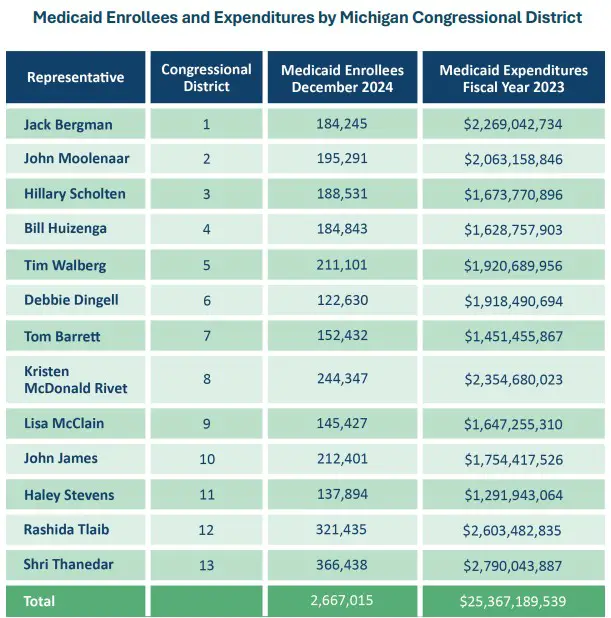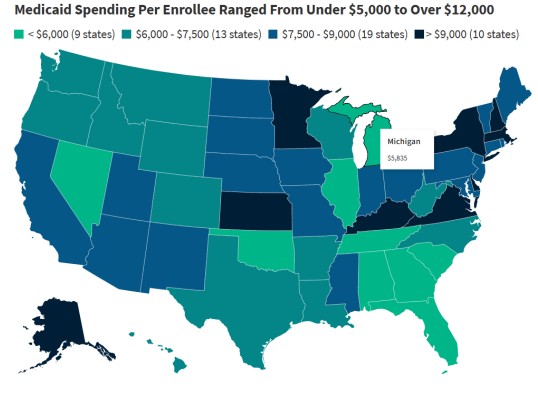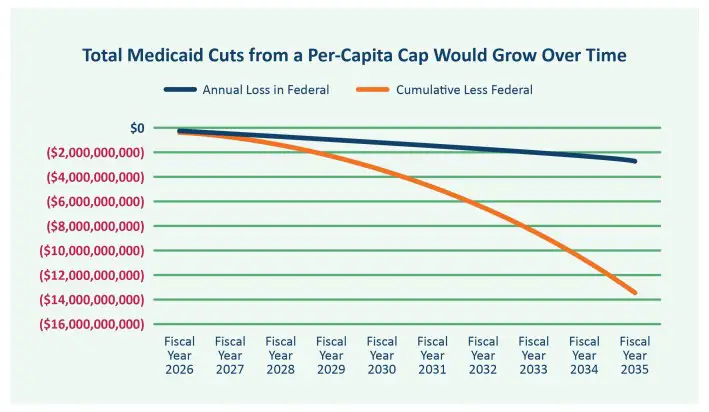Michigan faces a $2 billion shortfall as federal Medicaid cuts loom, threatening health care for 700,000 residents and destabilizing rural hospitals.
Michigan Faces Major Health, Economic Blow from Medicaid Cuts

and more than 2.6 million Michigan residents
LANSING, Mich. — In a press release issued this morning, Governor Gretchen Whitmer and state officials are sounding the alarm over proposed federal Medicaid cuts they say could strip health care from more than 700,000 Michiganders, slash hospital budgets, and destabilize rural communities.
A new report from the Michigan Department of Health and Human Services (MDHHS), conducted under Executive Directive 2025-3, paints a grim picture if federal lawmakers push forward with nearly $880 billion in Medicaid cuts over the next decade. These cuts would mark the largest reduction in the program’s 60-year history.
Federal Medicaid Cuts Would Hit Michigan Hard Across All Fronts

According to the MDHHS report, Michigan’s $27.8 billion Medicaid budget relies on about $19 billion in federal funding. The program covers roughly 2.6 million residents, including 1 million children, 300,000 people with disabilities, and 168,000 seniors. Importantly, 45% of all births in Michigan are covered by Medicaid.
If approved, the proposed cuts could wipe out $1.1 billion in state funding per year, forcing tough choices: either plug the hole with state dollars or remove hundreds of thousands from the Medicaid rolls.
Governor Whitmer warned, “More than 700,000 Michiganders including people fighting cancer, seniors in nursing homes, new moms, veterans, kids, and those living with disabilities could lose their health care.”
Michigan Medicaid Cuts: Local Impact in Huron, Sanilac, and Tuscola Counties
The proposed federal Medicaid cuts would strike hard at Michigan’s Thumb region, where rural residents are deeply reliant on the program. According to the MDHHS data, Medicaid plays a central role in health care access across Huron, Sanilac, and Tuscola counties, covering thousands of residents and supporting local hospitals and providers.
Here’s a snapshot of current enrollment and spending:
- Huron County: Population 31,407; Medicaid enrollees 6,962 (22% of residents); $95.5 million in Medicaid spending.
- Sanilac County: Population 40,611; Medicaid enrollees 11,182 (28% of residents); $106.5 million in spending.
- Tuscola County: Population 53,323; Medicaid enrollees 13,735 (26% of residents); $157.7 million in spending.
If federal cuts lead to the estimated 30% reduction in enrollment statewide, these counties could see the following numbers of residents lose coverage:
- Huron County: ~2,100 residents
- Sanilac County: ~3,350 residents
- Tuscola County: ~4,100 residents
Such losses would strain local health systems. Hospitals in these counties depend heavily on Medicaid reimbursements to keep services running, especially in maternity care, emergency services, and nursing home operations. For example, Medicaid funds more than 60% of births in some Michigan rural hospitals, making cuts a direct threat to local maternity wards.
The economic stakes are also high: combined, these counties receive more than $359 million in Medicaid funding, which supports not only health care access but also hundreds of local jobs. Cuts would likely increase uncompensated care, push residents to travel farther for health services, and heighten financial strain on already stretched rural hospitals and clinics.
Without Medicaid’s stabilizing role, health care access across Michigan’s Thumb could erode, deepening disparities between rural and urban parts of the state.
Rural Communities and Hospitals Face Unique Risks

Michigan’s rural communities stand to lose the most. Medicaid covers 37% of residents in these areas, and local hospitals often act as both health care providers and major employers. MDHHS Director Elizabeth Hertel cautioned that losing this funding could push rural hospitals to close, reduce provider access, and worsen health disparities.
Hospitals statewide already rely on Medicaid for an average of 22% of their patient volume, and the program brings in $7 billion annually, almost one-fifth of hospital net patient revenue.
Work Requirements and Provider Tax Reforms Could Deepen the Crisis
Beyond funding cuts, the report highlights additional threats, including reinstating work requirements. Michigan’s past experience with these rules showed nearly 80,000 residents lost coverage in the first month due to paperwork barriers, not failure to work.
The cuts also target Michigan’s provider tax system, which generates $3 billion in state Medicaid funding. Changing this system would slash hospital and nursing home payments and likely lead to service cuts.
Economic Ripples: Job Losses and Population Decline
Medicaid expansion has created more than 30,000 jobs in Michigan, driving $2.3 billion in personal income and $150 million in annual tax revenue. If federal cuts pass, the economic hit could push people out of the state, shrinking Michigan’s workforce and tax base.
State Budget Director Jen Flood underscored the stakes: “We don’t have the resources to fill a hole of that size without cutting access to health care, or cutting public safety, education, or services to veterans.”
Michigan’s Medicaid Efficiency Leaves Little Room to Absorb Cuts

spending per enrollee. Michigan ranks among the lowest-spending states on a per-enrollee basis
The report points out that Michigan already ranks among the lowest states for per-enrollee Medicaid spending, thanks to years of cost controls. Cuts to federal support would hit an already lean program, increasing the uninsured rate and piling on uncompensated hospital care.
Find More Interesting Feature Stories From ThumbWind
- Michigan Feature Stories — Unveiling the diverse and vibrant people, captivating places, and remarkable events that come together to make the Great Lake State unique and cherished by both residents and visitors alike.
- Weird Political News — A sarcastic take on official news from around the U.S., exploring the absurdities that often arise in the political landscape while providing a humorous perspective on current events and highlighting the quirks of politicians and policies.
- Michigan News — News and events from Michigan’s Upper Thumb region worth knowing, including local stories, impactful interviews, and updates on community happenings that shape the culture and lifestyle of the area.
Your Turn – Like This, or Loath it – We Want To Hear From You
Please offer an insightful and thoughtful comment. We review each response. Follow us to have other feature stories fill up your email box, or check us out on Newsbreak at ThumbWind Publications




